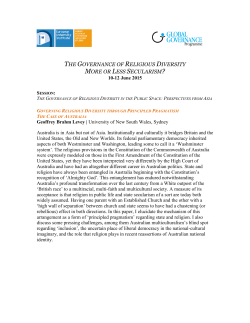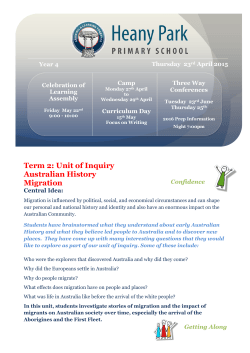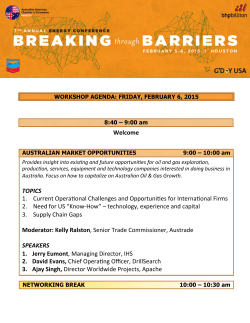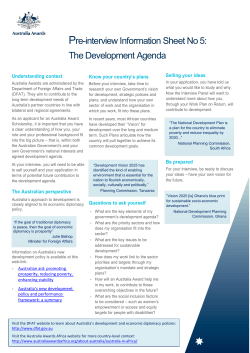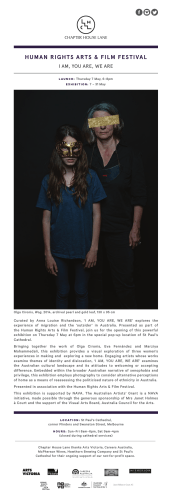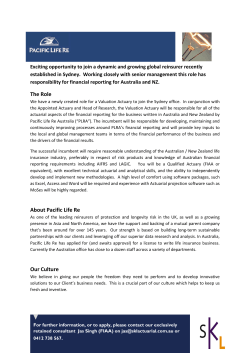
Blue Labor Transported â Janet McCalman
Blue Labor Transported Janet McCalman John Cain Foundation inaugural conference March 21 2015, Melbourne University That British and Australian Labor share so much is no accident. The colonies of Victoria and South Australia in particular were shaped by a generation of British, Irish and German radicals who sought to realize the shattered hopes of 1848 in a new world. In contrast to the former penal colonies, Victoria and South Australia were the creation of free immigrants. Most were literate and skilled. They brought habits of association, co-operation, mutual help and civil society and applied them, particularly in the Victorian gold fields. They sought to recreate the world of the old poor law, not the new that had criminalized poverty. The old poor law, instituted in 1601 to replace the charity provided by the now dissolved monasteries, was local, face-to-face, and as historians have painstakingly discovered from the archives, remarkably effective in protecting the British people against famine and destitution. The parish assumed the role of civic parent to orphans and bastards, ensuring their education and apprenticeship. The grammar schools and apprenticeship traditions of early modern Britain trained an exceptional workforce, whose skills and enterprise were the genesis of the industrial revolution that began in the mid-eighteen century. Britain’s exponential growth of population and wealth owed far more to the artisans of the Midlands than it did to the speculative dealings in the London coffee shops. But Britain stopped investing in its human capital in the nineteenth century. Innovation destroyed craft skills, and deskilled manufacturing. Urbanization overwhelmed the Old Poor Law, and after 1833, a repressive, coercive regime bore down on the thousands fleeing the loss of common land rights and rural destitution. 1 Emigration to the New World was one solution. The discovery of gold in Australia in 1851 swept aside the stigma of convictism that had deterred many free immigrants in the previous half century. And among those who took advantage of the Wakefield Scheme to South Australia or paid their own way to Victoria, were many who yearned for more than quick riches and cheap land. They wanted a decent, civil society for working people. In Victoria they established a working-class movement that saw many firsts: an eight-hour day from 1856, a Trades Hall from 1858, manhood suffrage and the miner’s right from 1856; the secret (or Australian) ballot; the first Labour man elected to parliament in 1859; a political labor movement from 1891; and a first Labor prime minister in 1904. In 1907 the Harvester Judgment enshrined the minimum or basic wage in law. It was an English, Scottish and Irish radical tradition built on trade unions, friendly societies, building societies and cooperatives. Every gold town had a voluntary hospital and a benevolent asylum for the destitute aged. Cooperatives flourished in rural districts. It drew on both a social Gospel and an increasing secular socialist tradition. Where it differed from England, but resembled Scotland, was the increasing toxic admixture of religious sectarianism that helped derail the contribution Catholic Social Thought could have made from the 1920s. The welfare state evolved first in societies where nuclear families predominated, to provide some care for those without families. It is a northern European phenomenon that England shared with Sweden and Denmark. In Scandinavia, as in Britain, the welfare state emerged from Christian doctrine: in Sweden it owes as much to Lutheranism as it does to Socialism. Administered through the parish and funded by a tax (the poor rate), the welfare system’s primary function, since the seventeenth century was to enable those without families to survive. The welfare state, therefore, is part of our cultural DNA like the common law, trial by jury, the presumption of innocence and parliamentary government. From the mid-nineteenth century the state developed another role: to protect the public from sickness and premature death and it is this function, that 2 historians of public health argue, expanded the size and reach of the modern state into everyday life more than any other. The mounting costs of medical care over time have forced states to organize, by amortising individual risk, health services that otherwise only the very rich could afford. Our embrace of centralized state reform shared a similar history to that of Britain, emboldened by the success of war government, labour and military conscription and a national will after two world wars and a great depression, to make the Brave New World safe, prosperous and fair. It was also funded by expanded state coffers from the patriotic preparedness of the rich to pay more tax in time of war. Modern mass society requires the provision of a range of public goods that because of their complexity—education, health, security, mobility—individuals cannot afford via a free market. Furthermore, the mutual help of the voluntarist model soon proved inadequate to protect working people from the vagaries of capitalism—the terrible booms and busts that have been particularly characteristic of New World settler societies extracting wealth from natural resources. Income support in times of unemployment, disability, sickness and old age have also proved, until the enforcement of compulsory superannuation— by a Labor government—beyond the resources of individuals or voluntarist institutions. But there were people left out of what has been called The Australian Settlement: Aboriginal Australians and the unskilled trapped in the irregular economy. These were two peoples who could not grow their human and social capital through education and training. They had no access to financial capital. Aboriginal people were excluded from all the entitlements of citizenship, except military service, in most states and territories, and even when ‘legally white’ as most Aboriginal Victorians were after the 1886 Half Castes Act, their entitlements were still not recognized. 3 The other group, the great army of unskilled workers—the white nomad tribes of the bush and the inner suburbs—were trapped by their semi-literacy and lack of vocational training in the world of casual work, midnight flits, and chronic insecurity. Only Victoria had a significant service industrial base and much of that was seasonal. Inner Sydney’s economy was still driven by the cycles of agriculture, as men worked between the city and the bush. Yet by 1938, as Australia recovered from the Great Depression and the unemployed were still visibly with us, there was a shortage of skilled workers. Australia had paid dearly for its lack of commitment to more than the most basic state education and a limited apprenticeship culture. A large segment of the population was essentially unemployable beyond the age of forty. Casual workers could not afford friendly society premiums, building society payments or even union dues. As they aged, they could no longer sell their muscles. Many were educationally so deprived that they were not very good at learning new skills. They were, what were called in the dark seventeenth century, ‘surplus mouths’. The growth the state with and after the war was to be their salvation: state instrumentalities providing electricity, gas, telephony, water, roads, dams, sewerage took on permanent workforces, adding to the security that railway and tram employment had always offered the unskilled. Until the Second World War, these services had been provided by casual, gang labour. The post-war labour shortage and the high taxation inherited from the war, enabled government bodies to provide secure work for unskilled men in great numbers for the first time in history. They were unionized, their children had access to apprenticeships and as even conservative politicians succumbed to community pressure, education beyond the age of fourteen. By the late 1950s Commonwealth Scholarships and especially high-value Teaching Studentships enabled working-class families to get to university also for the first time in Australian history. The middle class was remade and began to grow as it hadn’t, at least in Victoria, since the 1880s land boom. Families that had remained poor and excluded since their ancestors arrived as convicts or as assisted immigrants, saw their boom babies enter the professions. Enriched by 4 post-war European and later Asian migration, this country came alive, freed from the domination of a private school, Protestant and not very talented, fortunate few. The State was also the salvation of this new middle class in providing secure careers from administration and health, to education and services. Historically, middle-class options outside private enterprise and the professions had been severely limited. Downward mobility over the generations was very much an Australian immigrant story. Now it was possible for millions to be middle class and stay that way. This new class then made personal wealth from the appreciation in value of once cheap real estate in a brief window of opportunity between 1955 and 1970. This remains the genesis of most family wealth in this country. Thus the most dramatic role of the state in the lives of the Australian people since the middle of the twentieth century has been as an employer; that is until the neoliberal turn and the selling off of public utilities and the dismantling of public services. The middle class state workforce might have shrunk in technical areas like telecommunications, engineering and transport, but the white-collar knowledge workforce continued to expand. Now the fastest growing employment sector in the entire economy is health. We face a turning point, however. The economic model of the welfare state is faltering under demographic pressures, rising costs of medical technologies and services, declining economic performance and climate change. In fact it was costed for just one generation. For the first time in modern history, young people can look forward to being poorer than their parents. The intergenerational wealth divide already distorts our politics as the ageing wealth holders dominate the electorate. Families are changing. They are shrinking in size and dispersing geographically. Fewer and fewer of us will be able to call on siblings, cousins, uncles and aunts for support in the future and will need to look to institutional interventions. As 5 the welfare state becomes too expensive, new forms of association through friendship and community will need to replace these lost family networks But the workplace also is changing. Globalization and new technology have hollowed out manufacturing and now it is doing the same to the white-collar middle class, from call centres and administration, to conveyancing and pathology. The latest predictions from the champions of robotics, is that even waiters and baristas will soon be seen no more. Young people face a working life of short-term contracts, isolation, and increasing industrial weakness over incomes and working conditions. The state cannot supply all the buffers needed to see an individual or a family through the full lifecycle, nor perhaps should it. Therefore do we need to think about a new form of unionism to embrace short-contract or self–employed white -collar workers and professionals? This might provide, like the old friendly society did for self-contracting workers, insurance in times of unemployment as well as the health insurance, legal and financial advice and protection, and superannuation that are now available to union members. And like the old trade societies that supported independent tradesmen in the pre-industrial economy, networking for new jobs and contacts. Above all, it might increase solidarity. Could this supply a buffer for the middle class that might enable them to maintain a mortgage during slack times, for instance? And do we need to devolve to local communities forms of support and association that draw on citizens’ own capacities to address the problems of social exclusion and disability? Perhaps we might contemplate a ‘work for the pension’ obligation of voluntary service in the community? This is also in response to British Blue Labour’s critique of the cultural gulf that has opened up between the political class—the technocratic and professional middle class who remain, in their employment, the most significant beneficiaries of the expanded state—and the rest. The Left has always struggled with its intelligentsia nursing either romantic stereotypes of working-class authenticity or contempt for the philistinism of ‘chavs’ or ‘bogans’. Before the Holocaust, 6 many ‘progressive’ intellectuals were tempted by eugenics as the means of eradicating social problems by breeding out problem people. Perhaps the most unforgivable post-war failures of the middle-class Left intelligentsia was the appalling ideological self-indulgence of the 1970s and 1980s, fighting and splitting over philosophical differences while Reagan and Thatcher burned Rome. In the UK this necessitated the rise of New Labour for electoral repair; in this country, a Labor government itself taking a neo-liberal turn as John Langmore has eloquently lamented. In Australia, the responses have been different from the UK. Howard did seduce many as ‘Howard’s battlers’, but that did not last. When a plausible Labor prime minister appeared in Kevin Rudd, they were prepared to change. Refugees and migration have been manipulated as issues to divide people, but the Left does not help either the cause of the refugees or its own by reflexively blaming these anxieties on western suburbs racism and bogan backwardness. Neither is the inner city progressive intelligentsia entirely consistent in welcoming refugees everywhere in Australia other than where they live and in the schools their own children attend. We face genuine social apartheid in our inner city communities. But in fact, in this country, it has been the progressive middle class, not the old working class, that has split away from Labor and gone Green. And this privileged demographic unwittingly undermines the chances of reforming government, pursing a self-interested class agenda sometimes at the expense of Australian workers. They are guilty of arrogance. They are too inclined to preach and prescribe and in so doing, undermine the trust that is vital to public acceptance of expertise, for instance in climate change or indeed refugees. As one member of the Green’s state executive while teaching at Melbourne University inquired: “Why does Labor pander to bogans?” These toxic class tensions within the Left cannot continue. The threat of climate change, global population growth and economic stagnation pose too great a danger to the basic decencies that we have come to expect as citizens in developed countries and which must be extended to all those in developing 7 countries. Hence Maurice Glasman’s call for renewed forms of association and solidarity are more than timely. The middle class, that has done so well over the past 60 years, is now facing the same challenges as many working-class people. In the United States, it is being quietly impoverished; the young middle class here, is facing a bleaker future with impossible housing costs, mounting educational debts and diminishing prospects of secure lifelong employment, even in the learned professions. We are now all in the same boat. Both the middle and the working class need the expanded and expanding state, first for secure employment, second to amortise risk from illness, unemployment, disability and misfortune. But that does not justify a politics of ‘doing things to people’ that have been decided from above to be in their own best interests. That is not social democracy. The turn of history is throwing the interests of the middle and the working classes together. In times of severe crisis, currently those who have welfare and health buffers provided by the state, do better. As our visiting Miegunyah Fellow from University College Dublin, Professor Cecily Kelleher, has been arguing, in Ireland with the financial crisis, those who dropped out of health care were those in the commuter belts, who found themselves in negative equity but whose income was too low for private insurance. We now have an emerging struggling middle class, disproportionately young or disproportionately older, female and living alone. We will see a return to what was once called ‘genteel poverty’ and an increasingly insecure youth. This is on top of the growing number of almost unemployable young people for whom our modern service economy has no place. Our biggest and most difficult task, and it is one that needs a political solution, is to provide secure meaningful work across society for all those who desire it: the unskilled, the semi-literate, the newly arrived, the young graduate, the mid-life retrenched, the older worker and the disabled. 8 This is a massive economic and political challenge. It will only be met by collective, focused and imaginative grass-roots energy that emboldens political will. To achieve that we need new forms of solidarity that unite workers and non-workers of all kinds, of all social strata, against the common enemies of the top one per cent who have profited so obscenely from neoliberalism and the new transnational CEO class that secures inflated salaries and privileges across all sectors from business to government to universities to NGOs and even to unions. This class, which exercises immense power in business, government and institutions, is loyal only to itself. It is the source of the shameful corruption in the union movement. It is the cause of appalling waste in the delivery of services to people in need. In the case of universities, the CEO class appears to have lost any sense that they are servants of public institutions that exist in their turn to serve their nations and their regions. A new grass-roots politics of solidarity, pursuing what Maurice Glasman calls the ‘common good’, may be our only defence against middle-class NIMBYISM, sectional vested interests and indeed corruption. The time has come for a new conversation about the state: not so much about its size but about its morality and purpose. It is there to serve us. We need to restore its human face. We need to revisit ideals of service to others as the essence of good citizenship and leadership. And that can only come from people working together, not collections of egos proclaiming their unique views and superior moral selves. The Labor Party has many flaws. It has a few awful people in it. It has made huge mistakes and always will. But it is, as Gough Whitlam realized when he committed himself to a life of service to Labor, the only mass movement in this country which has brought about genuine change and social justice over the past hundred and sixty years. If we lose the Labor party, we lose everything. We cannot rely on moral vanguards like Bob Brown’s ‘six percent’ of enlightened Greens to change the world. That is not democracy; that is in fact the road to tyranny. Virtually everything that makes Australia a good society had its genesis in political and industrial Labor. Conservatives have often carried through with these initiatives, but they have sprung from the Labor well. 9 We need to refresh from the grassroots; connect with each other; listen and learn; imagine and do. A creative, democratic mass political movement is not about following a great leader, but about relationships with each other and a commitment to the common good. It must involve stronger ties with unions and union members as active Labor members. It demands that branch members extend their imaginations beyond their own localities and sectional interests. It requires the recognition of shared interests and sympathies. It is about finding leadership in ourselves, as did the gold miners who marched through town to celebrate the opening of their Castlemaine Benevolent Asylum in 1860. There is no way that we can devolve health, education and infrastructure to the private sphere without exacerbating inequality and social injustice. We cannot therefore, shrink the state just as the family and the planet are shrinking. But there may be ways we can revive left traditions of mutual help and solidarity to engage individuals with the needs of others like themselves, to protect citizens and communities against insecurity and marginalization and to mobilise political energy. We need to build trust between classes, religions, ethnic groups, the sexes. We need a politics where we the people can own the future. 10
© Copyright 2025
